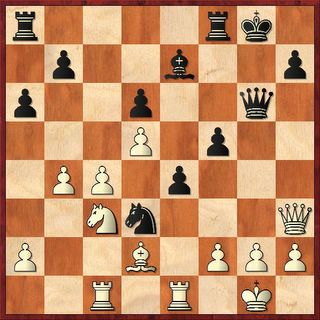2006 February Toledo Swiss, 2.11.2006
Sicilian Defense: Sveshnikov Variation [B33]
1.e4 c5 2.Nf3 Nc6 3.d4 cxd4 4.Nxd4 Nf6 5.Nc3 e5 6.Ndb5 d6 7.Nd5 Nxd5
Forced.
8.exd5 Nb8
GM Neil McDonald gives this move an exclamation mark.
9.c4 Be7 10.Be3
The book indicates that Be2 is the usual move at this point. Furthermore, this bishop will be driven away soon with f5-f4.
10...0-0 11.Be2 a6 12.Nc3 f5
White will sometimes meet this with f2 and Be3, with the idea of parking the bishop on f2 if he gets the chance.
13.0-0 f4 14.Bd2
I am sure Bc1 was better because I wind up spending two tempi trying to maneuver my light squared bishop onto the b1-g7 diagonal. Bd3 would have been the immediate response if the bishop had withdrawn to c1. This begs the question, why did the dark squared bishop get developed to e3 to begin with. If white is going to play this, then he needs to plan to play f3 and shelted the bishop on f2.
14...Bf5 15.Bf3 Nd7
Note that Bd3 would have been met with Be2.
16.Be4 Qe8
Surely this move was played to develop the queen to g6.
17.Re1 g6
This is curious, and seems to conflict with the move Qe8 played just one move earlier. The queen is now blocked in and has no impact on the game whatosever.
18.Rc1 Nc5
With an eye on a potential rook fork on d3.
19.Bxf5 gxf5 20.Qe2 Qg6
After Qg6 my eye was immediately drawn to the unprotected bishop on e7. Bxf4 doesn't quite work because of exf4 Qxe7 and Nd3 forking the white rooks.
21.b4
My goal was to drive the knight away from c5, so that I could play the combination to win the bishop on e7.
21...f3
This tactic enables black to play e4 with tempo and simultaneously give the knight an advanced support point, namely the critical d3 square.
22.Qxf3
White is forced to capture the pawn.
22...e4 23.Qh3
This was necessary to keep the g-file accessible for the rook on e1. Otherwise, white will not be able to prevent black from winning the exchange.
23...Nd3

24.Re3 Bg5
This skewer really changes nothing. The rook can still take control of the g-file and this will open up a discovered attack on the g5 bishop.
25.Rg3 f4??
I was certain Will was going to play h6, but f4 seals his fate.
26.Rxg5! Qxg5 27.Nxe4 Qg6 28.Qxd3
The point behind the temporatry sacrifice exchange.
28...f3 29.g3 Rae8 30.Re1 Qf5
This allows Bh6, but I didn't realize that the black response Qh3 produces a forced mate after Nxf6 Rxf6 Rxe8+ to follow and then mate in 3.
31.Re3 Qg6 32.h4
I played this to prevent simple back rank mates.
32...Re5 33.Ng5
Bc3 was stronger.
33...Ref5
Black doesn't want to trade off pieces.
34.Bc3
This stalemates the black king.
34...Qh5 35.Qd4
Threatening mate.
35...R8f6 36.Qe4
Discovered attack on the f6 rook.
36...Rf7 37.Qe8+
Avoiding cashing in too early with Nxf7 allows white to win the queen.
37...Rf8 38.Qxh5 1-0

No comments:
Post a Comment